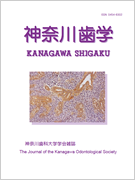- HOME
- > 一般の方
- > バックナンバー:神奈川歯学
- > 58巻2号
- > アブストラクト
アブストラクト(58巻2号:神奈川歯学)

Japanese
| Title : | マウス歯髄幹細胞を用いた骨再生技術開発のための基礎的研究 |
|---|---|
| Subtitle : | 原著 |
| Authors : | 原田隆史1,2,3), 安部貴大1,3), 古村浩子2,4), 西田朋世3), 田中香衣1), 白石晃平2,3,4), 浅輪幸世2,4), 星和人3,4), 古村眞2,4) |
| Authors(kana) : | |
| Organization : | 1)神奈川歯科大学歯学部臨床科学系口腔外科学講座口腔外科学分野, 2)東京大学大学院医学系研究科組織幹細胞・生命歯科学講座, 3)東京大学大学院医学系研究科外科学専攻感覚・運動機能医学講座口腔顎顔面外科学, 4)東京大学医学部附属病院ティッシュエンジニアリング部 |
| Journal : | 神奈川歯学 |
| Volume : | 58 |
| Number : | 2 |
| Page : | 90-98 |
| Year/Month : | 2023 / 12 |
| Article : | 原著 |
| Publisher : | 神奈川歯科大学学会 |
| Abstract : | 「緒言」口腔外科領域の癌や炎症, 先天性顎裂などにかかわる骨欠損は, 顔貌だけでなく, 咀嚼機能にも関わる状態である. 腸骨や腓骨を用いた自家骨移植が, 顎骨骨欠損部治療のゴールドスタンダードとされているが, 侵襲が大きく, 供給側の感染リスクを伴う. 組織工学(Tissue engineering)は, 細胞, 足場, 成長因子の3要素によって組織・臓器を再生させる概念とされている. この概念を利用して, 自己再生能力の旺盛な骨欠損部位に, ハイドロキシアパタイトやβ-TCPなどの無機質材料が移植されて治療が行われている. 無機質材料の骨欠損部への補填は, 骨髄からの骨芽細胞の遊走と成長因子の生成が骨再生に大きく関与する. しかし, 足場材料のみの移植では, 骨誘導性が低いとされている. これは, 再生初期に組織再生に必要な幹細胞と成長因子が存在しないことにより, 再生のスタートに遅れが生じることが大きな要因と考えられる. |
| Practice : | 歯科学 |
| Keywords : | マウス歯髄細胞, 歯髄間葉系幹細胞, 歯髄単離法, 骨再生 |
English
| Title : | Basic study on mouse dental pulp cells for the development of bone regeneration technology |
|---|---|
| Subtitle : | |
| Authors : | Takafumi HARADA1,2,3), Takahiro ABE1,3), Hiroko KOMURA2,4), Tomoyo NISHIDA3), Kae TANAKA1), Kohei SHIRAISHI2,3,4), Yukiyo ASAWA2,4), Kazuto HOSHI3,4), Makoto KOMURA2,4) |
| Authors(kana) : | |
| Organization : | 1)Department of Oral and Maxillofacial Surgery, Graduate School of Dentistry, Kanagawa Dental University, 2)Tissue stem cell/Life Dental Science, Graduate School of Medicine, The University of Tokyo, 3)Department of Sensory and Motor System Medicine, Graduate School of Medicine, The University of Tokyo, 4)Department of Tissue Engineering, The University of Tokyo Hospital |
| Journal : | Kanagawa Shigaku |
| Volume : | 58 |
| Number : | 2 |
| Page : | 90-98 |
| Year/Month : | 2023 / 12 |
| Article : | Original article |
| Publisher : | Kanagawa Odontological Society |
| Abstract : | [Abstract] Bone defects in the field of oral surgery are a pathological condition that relates not only to facial appearance but also to masticatory function. Autologous bone grafting is considered the gold standard for the treatment of jaw bone defects, but it is highly invasive. Bone regeneration therapy with hydroxyapatite or β-TCP is reported to have poor osteoinductive properties. Bone regeneration is possible by three-factor tissue engineering with cells, scaffolds and growth factors. The aim of this study was to isolate and culture mouse dental pulp stem cells and to create a bone regeneration model using scaffold materials. Three-week-old C57BL/6 mouse upper and lower molars were extracted and enzyme treated with collagenase to exfoliate the periodontal tissue, and then the teeth were crushed and enzyme treated with collagenase again to establish a combination culture method using pulp tissue fragments and dispersed pulp cells in a tissue explant culture method and cell dispersion method. Cultured dental pulp cells showed surface marker expression of mesenchymal stem cells and the ability to differentiate into osteoblasts in vitro. Mouse dental pulp cells were also seeded on octacalcium phosphate/collagen composite (OCP/Col) scaffold material and transplanted into a 3.5mm diameter bone defect created in the skull of an allogeneic mouse. OCP/Col seeded with dental pulp cells showed significant bone regeneration (CT and histological observations) compared without cell seeding. This study established a method for the isolation and culture of mouse dental pulp stem cells using a combination culture method and successfully created a bone regeneration model by seeding dental pulp cells on a resorbable scaffold material. |
| Practice : | Dentistry |
| Keywords : |
